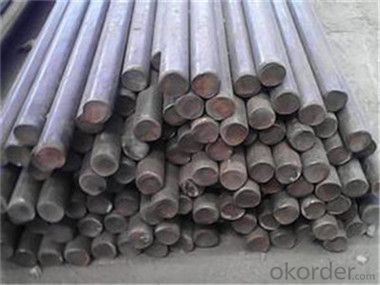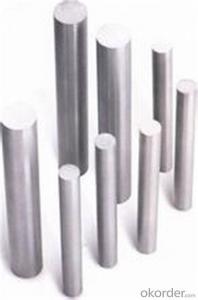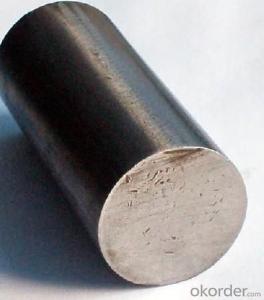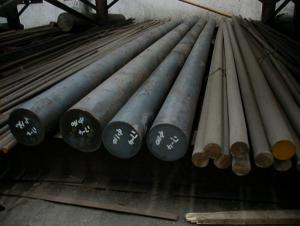Steel Round Bar with High Quality Cheaper SAE1018CR
- Loading Port:
- Tianjin
- Payment Terms:
- TT OR LC
- Min Order Qty:
- 80 m.t.
- Supply Capability:
- 2000000 m.t./month
OKorder Service Pledge
OKorder Financial Service
You Might Also Like
Item specifice
Description of steel round bar:
Mild steel is sometimes referred to as carbon steel or plain steel. Typically, it is stiff and strong. Carbon steelsdo rust easily, but they can be easily painted or primed. They are cheap so they are the normal choice for most fabrications. Mild Steel can be easily cut or drilled to meet your requests.
Mild Steel Round Bar is used for making security grills, screens, Construction and Machine Manufacture.
Festures of steel round bar:
Can be used in the manufacture of high capacity cutting tools to bear impact force ,such as gear shaper cutter, milling cutter,screw tap,drill bit etc.Also can be used in manufacture of large scale and thermoplasticity shaped cutting tools and antiabrasive cutting tools under high load.
Specifications of steel round bar:
steel c45 s355 scm440
sae 1045 material /s45c carbon steel/sae 1045 steel round bars /
c45 STEEL/round steel material 1035 1040 1045
Grade:C45 S45C CK45 1.0503 EN8 SAE1045 AISI 1045
Diameter:10mm-300mm
Images of steel round bar:

FAQ:
1. What is your package?
Packing situation: standard seaworthy packing or as customer required.
2. How long is the lead time?
Delivery time: 45 days after order confirmed.
3. What payment term do you accept?
Payment: T/T or L/C at sight.
- Q:Can steel round bars be used for making agricultural equipment or machinery?
- Yes, steel round bars can be used for making agricultural equipment or machinery. Steel is a versatile and durable material that is commonly used in the manufacturing of various agricultural equipment and machinery. Steel round bars, in particular, are often utilized for making components such as shafts, axles, and rods that are crucial for the functioning of agricultural machinery. These round bars provide strength, stability, and resistance to wear and tear, making them suitable for heavy-duty applications in the agricultural industry. Additionally, steel is also corrosion-resistant, which is especially important in agriculture where equipment is exposed to harsh environmental conditions. Overall, steel round bars are a reliable choice for constructing agricultural equipment or machinery due to their mechanical properties and ability to withstand the demanding conditions of agricultural operations.
- Q:How do steel round bars compare to carbon fiber round bars?
- Steel round bars and carbon fiber round bars are materials commonly used in various industries, but they differ in several aspects. Strength and Durability: Steel round bars are renowned for their exceptional strength and durability, enabling them to withstand heavy loads, high temperatures, and harsh environments. On the other hand, carbon fiber round bars are also strong but generally not as strong as steel bars. However, they have a remarkable strength-to-weight ratio, making them a popular choice when weight reduction is crucial. Weight: One noticeable difference is the weight. Steel round bars are significantly heavier compared to carbon fiber round bars. This weight disparity often makes carbon fiber bars more preferable in industries where reducing weight is important, like aerospace and automotive sectors. The use of lighter bars can contribute to improved fuel efficiency, increased speed, and enhanced maneuverability. Corrosion Resistance: Steel round bars are susceptible to corrosion, especially when exposed to moisture and specific chemicals. Regular maintenance and protective coatings are often necessary to prevent rusting. Conversely, carbon fiber round bars possess inherent corrosion resistance. This property makes them valuable in environments where corrosion is a concern, such as marine applications. Flexibility and Stiffness: Steel round bars are generally stiffer and less flexible compared to carbon fiber round bars. This characteristic is advantageous in applications where rigidity and structural integrity are crucial, like construction and heavy machinery. In contrast, carbon fiber round bars offer higher flexibility and can be engineered to have varying levels of stiffness, making them suitable for applications requiring vibration damping or enhanced shock absorption. Cost: In terms of cost-effectiveness, steel round bars usually have the upper hand. Steel is widely available, and its production costs are relatively low. Carbon fiber, however, is more expensive to produce due to the complex manufacturing process and the cost of raw materials. Consequently, carbon fiber round bars tend to be pricier and are limited to industries where their unique properties justify the increased costs. In conclusion, steel round bars and carbon fiber round bars have their own advantages and disadvantages. Steel bars offer exceptional strength, durability, and cost-effectiveness, while carbon fiber bars excel in weight reduction, corrosion resistance, flexibility, and stiffness. The choice between the two depends on the specific requirements of the application, including factors such as load-bearing capacity, weight reduction, corrosion resistance, and cost considerations.
- Q:How are steel round bars used in the manufacturing of valves and fittings?
- Valve and fitting manufacturing commonly utilizes steel round bars for their strength, durability, and versatility. These bars serve as the primary raw material for various valve and fitting components. A significant application of steel round bars in valve manufacturing involves producing valve stems. Valve stems control fluid or gas flow through the valve. The round bars are machined and threaded to create the stem, which connects to the valve disc or plug. Steel round bars are chosen for this purpose due to their high tensile strength, ensuring the stem can withstand the required pressure and torque to operate the valve. In fittings manufacturing, steel round bars are frequently used to produce threaded connectors, nipples, and couplings. These components are integral for joining pipes or tubes, enabling fluid or gas transfer in different systems. Steel round bars are easily machinable, allowing manufacturers to create precise threads and shapes necessary for these fittings. Additionally, steel round bars are also employed in fabricating the body or housing of valves and fittings. The bars can be cut, forged, or machined into the desired shape, providing a robust and dependable structure for the valve or fitting. The use of steel in the body guarantees the component's ability to endure high pressures, temperature fluctuations, and corrosive environments. In conclusion, steel round bars have a crucial role in valve and fitting manufacturing. Their strength, durability, and machinability make them an exceptional choice for creating vital components like valve stems, threaded connectors, and the bodies of valves and fittings.
- Q:How do you measure the straightness of a steel round bar?
- One common method to measure the straightness of a steel round bar is by using a straight edge or a precision ruler. By placing the straight edge along the length of the bar and observing any gaps or deviations between the two, one can determine the straightness. Additionally, a laser alignment tool can also be used to measure and identify any bends or irregularities in the bar's straightness.
- Q:What is round steel?
- More than 25 mm round steel, mainly used in the manufacture of mechanical parts or between round steel and other steel seamless steel tube blank: 1 is not the same, round shape light round, no pattern without ribs, other steel surface appearance is engraved or ribbed. Bond thus causing steel and concrete, and the bond strength.2 other components of steel and concrete are not the same, round (a steel) belongs to the ordinary low carbon steel, alloy steel reinforced many other.3 strength is not the same. The low strength steel, and other steel with high strength, the diameter of the same size as compared with other steel, round steel can bear the pulling force than other small steel however, plastic steel reinforced bar is stronger than the other, there is a large deformation in the break before, while the other bars in the break before the deformation is much smaller.
- Q:What is the difference between a bright and a black steel round bar?
- The main difference between a bright and a black steel round bar lies in their appearance and surface finish. A bright steel round bar, also known as a bright drawn or turned bar, has a smooth and shiny surface. This is achieved through a process called cold drawing, where the steel bar is pulled through a die to remove any imperfections and create a uniform shape. The result is a highly polished and reflective surface that is visually appealing. On the other hand, a black steel round bar has a dark, rough, and non-reflective surface. This is because it does not undergo the same cold drawing process as a bright steel bar. The black surface is typically a result of the scale that forms on the steel during the manufacturing process, which is not removed. In terms of properties, both bright and black steel round bars are made of the same material, typically carbon steel. Therefore, their mechanical properties such as strength, hardness, and toughness are generally similar. However, the manufacturing process of the bright steel bar helps to improve its surface quality and dimensional accuracy compared to the black steel bar. Ultimately, the choice between a bright and a black steel round bar depends on the desired aesthetic appearance and the specific application requirements. Bright steel bars are commonly used in decorative applications, where a polished and visually appealing finish is desired. Black steel bars, on the other hand, are often used in structural applications, where the surface appearance is less important but strength and durability are crucial.
- Q:How do you measure the diameter of a steel round bar?
- To measure the diameter of a steel round bar, you can use a caliper or a micrometer. First, ensure that the round bar is clean and free from any debris or rough edges. Place the round bar on a flat surface. If you have a caliper, open it and position one jaw on one side of the round bar and the other jaw on the opposite side. Make sure that the jaws are aligned perpendicular to the bar and are in contact with the outer surface. Gently close the caliper until both jaws are firmly against the bar. Read the measurement on the caliper's scale or digital display. This will give you the diameter of the round bar. Alternatively, if you have a micrometer, open it and set the thimble to zero. Position the anvil (stationary part) against one side of the round bar and the spindle (moving part) against the opposite side. Rotate the thimble until the spindle firmly contacts the bar. Read the measurement on the thimble's scale or digital display along with the corresponding number on the barrel. This will give you the diameter of the round bar. Remember to take multiple measurements at various points along the bar to ensure accuracy, as the round bar might not have a perfectly uniform diameter throughout its length.
- Q:How do I determine the load capacity of a steel round bar?
- To ascertain the load capacity of a steel round bar, one must take into account a range of factors. The load capacity of said round bar is contingent upon its diameter, length, and the specific steel variant employed. The ensuing steps elucidate the process of determining the load capacity: 1. Ascertain the steel grade: Distinct steel grades exhibit distinct strength properties. A few examples of common steel grades are A36, A572, and 4140. To pinpoint the precise grade of the steel round bar at hand, reference the specifications or seek guidance from an engineer. 2. Calculate the cross-sectional area: Employ the formula A = πr² to compute the cross-sectional area of the round bar, with A representing the area and r representing the radius of said bar. Remember to convert the diameter to radius by dividing it by 2. 3. Determine the allowable stress: The allowable stress denotes the maximum stress that a material can endure prior to deformation or failure. This value can be gleaned from engineering handbooks or through consultation with an engineer. 4. Apply the load capacity formula: Compute the load capacity of the round bar using the formula Load Capacity = Allowable Stress × Cross-sectional Area. 5. Account for safety factors: In engineering applications, it is customary to incorporate safety factors to ensure the safety of the structure. The specific safety factors hinge upon the application in question and the desired level of reliability. To ascertain the ultimate load capacity, reference the appropriate safety factor for your project. It is crucial to acknowledge that calculating the load capacity of a steel round bar is a multifaceted procedure necessitating expertise in structural engineering. If any uncertainty arises or precise calculations are required, it is advisable to seek the guidance of a qualified engineer who can furnish detailed analysis predicated on the specific parameters of your project.
- Q:What are the different types of finishes available for steel round bars?
- There are several different types of finishes available for steel round bars, each offering unique properties and appearances. 1. Mill Finish: This is the most basic and widely used finish for steel round bars. It is achieved by leaving the steel in its natural state after it has been rolled and cooled. Mill finish bars have a rough texture and may display surface imperfections. 2. Hot Rolled Finish: This finish is achieved by heating the steel to high temperatures and rolling it to form the desired shape. Hot rolled bars have a smooth surface and are typically used in applications where aesthetics are not a priority. 3. Cold Drawn Finish: Cold drawing is a process that involves pulling the steel through a die to reduce its diameter and increase its length. This finish results in a smooth surface with improved dimensional accuracy and tighter tolerances. 4. Polished Finish: Steel round bars can also be polished to achieve a smooth and reflective surface. Polishing is typically done using abrasive materials or compounds that remove surface imperfections and enhance the appearance of the steel. 5. Ground Finish: Ground finish involves removing a thin layer of material from the surface of the steel using abrasive grinding wheels. This process creates a smooth and even surface finish, suitable for applications that require tight tolerances and precise dimensions. 6. Coated Finish: Steel round bars can be coated with various materials to provide additional protection against corrosion or to enhance their appearance. Common coatings include galvanization, which applies a layer of zinc to the surface, and powder coating, which provides a durable and decorative finish. The choice of finish for a steel round bar depends on the specific application and desired properties. It is important to consider factors such as corrosion resistance, aesthetics, dimensional accuracy, and surface quality when selecting a finish.
- Q:What are the advantages of using mild steel round bars?
- Using mild steel round bars in various applications offers several advantages. To begin with, mild steel round bars exhibit exceptional strength and durability. They have the capacity to withstand high levels of stress and pressure, rendering them suitable for use in construction, manufacturing, and engineering ventures. The robustness of mild steel round bars ensures that they do not readily deform or fracture under heavy loads, providing a dependable and long-lasting solution. Furthermore, mild steel round bars possess favorable weldability. They can be easily joined or affixed to other materials through welding, granting them versatility across different applications. This allows for effortless customization and flexibility in design, as the bars can be shaped and connected to form intricate structures or components. In addition, mild steel round bars feature a low carbon content, making them more cost-effective in comparison to alternative steel types. They are readily available and affordable, making them a popular choice within various industries. Moreover, mild steel round bars exhibit excellent machinability. They can be effortlessly cut, drilled, and shaped using common machining techniques, facilitating easy fabrication and customization. This renders them suitable for a wide array of applications, ranging from construction to automotive components. Lastly, mild steel round bars offer commendable corrosion resistance. Although they may not possess the same level of corrosion resistance as stainless steel, they still provide adequate protection against rust and other forms of corrosion. This renders them suitable for outdoor applications or environments with high levels of humidity or exposure to moisture. In conclusion, the advantages of utilizing mild steel round bars include their exceptional strength and durability, favorable weldability, cost-effectiveness, machinability, and corrosion resistance. These factors make them a reliable and versatile choice for various industrial and construction applications.
1. Manufacturer Overview |
|
|---|---|
| Location | |
| Year Established | |
| Annual Output Value | |
| Main Markets | |
| Company Certifications | |
2. Manufacturer Certificates |
|
|---|---|
| a) Certification Name | |
| Range | |
| Reference | |
| Validity Period | |
3. Manufacturer Capability |
|
|---|---|
| a)Trade Capacity | |
| Nearest Port | |
| Export Percentage | |
| No.of Employees in Trade Department | |
| Language Spoken: | |
| b)Factory Information | |
| Factory Size: | |
| No. of Production Lines | |
| Contract Manufacturing | |
| Product Price Range | |
Send your message to us
Steel Round Bar with High Quality Cheaper SAE1018CR
- Loading Port:
- Tianjin
- Payment Terms:
- TT OR LC
- Min Order Qty:
- 80 m.t.
- Supply Capability:
- 2000000 m.t./month
OKorder Service Pledge
OKorder Financial Service
Similar products
New products
Hot products
Related keywords































